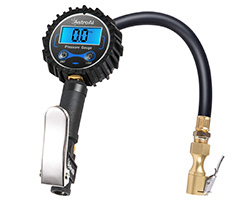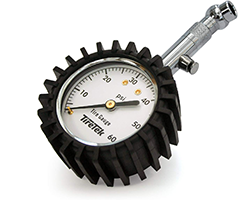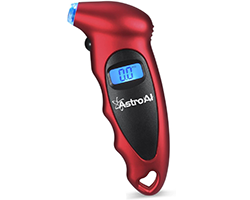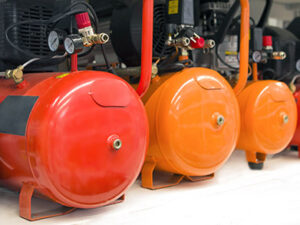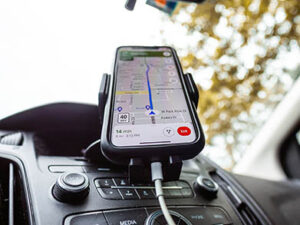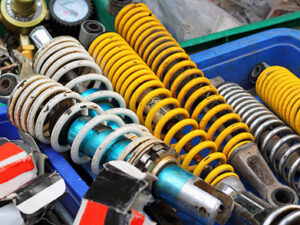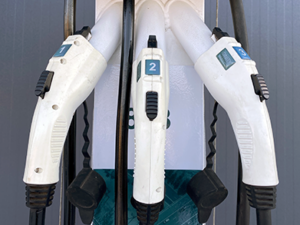Home \ Shop \ Automotive Tools & Equipment \ Tire Pressure Gauges
The Best Tire Pressure Gauges in 2025 (Review and Buyer’s Guide)
The "must-have" attribute in each automotive garage. Make the car better driven and comfortable on the road by keeping the tires properly inflated.
- 1. Review of The Best Pressure Gauges
- 2. ASTROAI Digital Tire Inflator with Pressure Gauge
- 3. TIRETEK Premium Car Tire Pressure Gauge 60 PSI
- 4. ASTROAI Digital Tire Pressure Gauge 150 PSI
- 5. JACO ElitePro Tire Pressure Gauge 100 PSI
- 6. ASTRO PNEUMATIC 3018 Digital Tire Inflator with Hose
- 7. AZUNO Digital Tire Inflator with Pressure Gauge (200 PSI)
- 8. RHINO USA Digital Tire Pressure Gauge 150 PSI
- 9. MILTON S-921 Pencil Tire Pressure Gauge
- 10. Why Do Car Owners Need a Tire Pressure Gauge on Board?
- 11. How to Pick Out the Best Tire Pressure Gauge?
- 12. Which tire pressure gauges require batteries?
- 13. What are all the different pressure units?
- 14. Can I use pressure gauges on other types of tires?
- 15. What is the optimal tire pressure level for cars?
- 16. How to Use a Tire Pressure Gauge?
- 17. Side Note: Winter
Tire pressure gauges are a very important tool when it comes to car maintenance and precaution. Some people might get the impression that they are simply used to monitor your pressure levels (and to some extent, that is correct), but the benefits of doing so go beyond this assessment.
An in-depth study conducted by the National Highway Traffic Safety Administration (NHTSA) found that over 70% of cars of the model year 2004-2011 had at least one underinflated tire. The same study notes that underinflation is a key cause of tire failure, and can lead to decreased fuel economy, longer stopping distances, and increased stress on the tires. Overinflating, on the other hand, can lead to similar drawbacks, and can contribute to vehicle instability. Essentially, having proper tire pressure levels can both prevent tire failure and minimize issues on the road.
Related post: The Best Roadside Emergency Kits
While best tire pressure gauges are vital in keeping your car on the road without a hitch, it’s important to pick out one that is both effective and easy-to-use for you. We have compiled eight of the best pressure gauges available today, and outlined the areas in which they are convincing, be it effectiveness or price.
Review of The Best Pressure Gauges

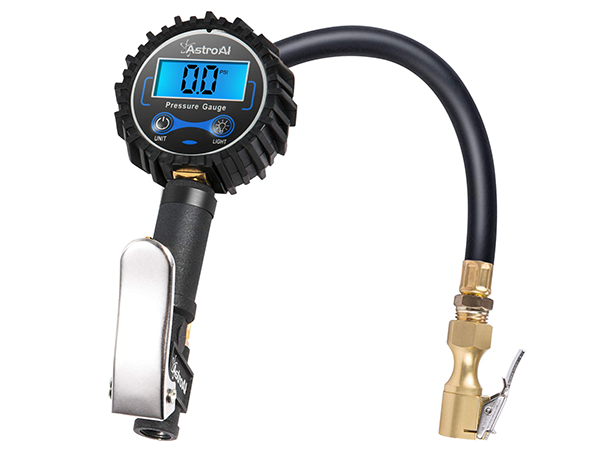
PROS
- High quality, heavy duty steel body
- Range of reading units (PSI, KPA, Bar, and Kg/cm²)
- Accurately measures a range from 0-250 PSI
- All in one unit
CONS
- No significant downsides
The AstroAI inflator/gauge is our top pick; it is user-friendly and accurate, with a №1 Best Seller on Amazon tag to back that up. Its convenient design is supported by its versatility and precision, giving you a safe and long-lasting window into tire pressure monitoring.
It is accurate and has great readability due to an LCD screen.
The LED-backlit screen can give you pressure results in four different units – PSI, bar, kPa, and Kg/cm² – in case one of them is more familiar to you. It can measure up to 250 PSI, which is quite the range for a simple and user-friendly tool. The durable construction has very little to complain about, with heavy-duty brass and steel parts ensuring the longevity of your gauge. It is calibrated to read pressure within a 1% error range, giving you results to the tenth of a unit.
A good bonus for the unseasoned mechanics out there is the fact it comes as a full set: chuck, bleed valve, hose, gauge, and the inflation gun itself. To top it all off, it is very affordable, providing a near-professional device at a convenient price point. Overall, there is very little to criticize about this product, and its ergonomic and user-friendly design was readily noted by buyers.

PROS
- Heavy-duty construction
- ANSI Certified Accurate
- Retains reading after removal
- No batteries required
- Can bleed air if overinflated
CONS
- No significant downsides
TireTek’s contribution into the tire pressure gauge world is a remarkable one, offering a very simple but reliable solution to pressure readings. Unlike the AstroAI, it’s a fairly basic pressure gauge with no other components (i.e. inflation gun). However, like the AstroAI, it gets the job done dependably.
We pick it out as simple, lightweight, reliable, and effective.
If you’re only in the market for a pressure gauge, the TireTek is a solid choice. Perhaps expectably, it is very affordable due to the simplicity of the product. It falls short in a couple of minor areas, such as only being certified as Grade B accuracy (within 2%), but this is precise enough to not be a major drawback. In addition, it is an analog meter, which might make reading exact psi a bit more tricky than with a digital alternative.
However, there are several benefits this product offers. Firstly, it is heavy-duty and reliable, as the simplicity of the design is coupled with very durable construction. It is easy to grip and use, and the bleed valve can even let you let out some air if the pressure is too high. The chuck can swivel in place fully, but this has proved to be a bit inconvenient for many buyers – seeing as the gauge retains the reading once it is disconnected anyway, it makes little sense to have such a potentially faulty feature.
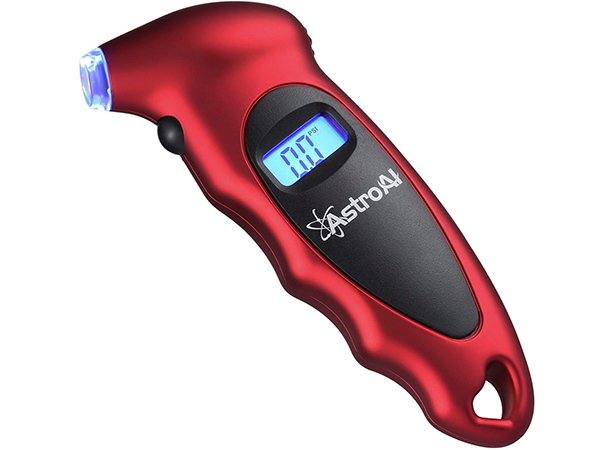
PROS
- Ergonomic and durable
- Extremely affordable
- Warranty included
- Great for beginners
CONS
- No precision standard outlined
If your budget is tight and you’re in need of a reliable digital pressure gauge, this might be worth a look. Another AstroAI product, this model is just as user-friendly and reliable as its counterpart, with the exception of having inflation capability.
We found that it’s a light and useful solution, keeping it onboard is a good idea.
While this model isn’t on here solely because of its affordability, it’s certainly a contributing factor to its ranking on this list. Its durability, ergonomic design, and precision are perhaps unparalleled at this price range. Like the other AstroAI model, this one also provides readings in four different units (PSI, bar, Kg/cm², and kPa) to a 0.1 increment. The design is very user-friendly, however, with aspects such as finger ridges making it easy to hold and prevent slip.
Like its counterpart, it also has an auto-off feature, keeping your results for 30-40 seconds before shutting off to conserve battery life. The LCD-lit screen and light, comfortable feel of this gauge is something that makes it perfect for the average driver. In case you end up not liking or needing it in the future, you can rely on the 1-year warranty to ensure there is no money lost. Overall, this is a perfectly sound choice on a budget.
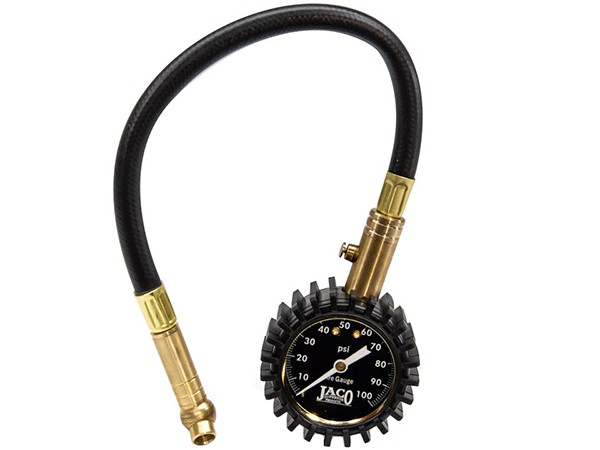
PROS
- High-quality and durable
- Comes with hose
- Lifetime satisfaction guarantee
- Accurate up to 100 PSI
CONS
- No significant downsides
You might notice, right off the bat, that the ElitePro pressure gauge is similar in many ways to the TireTek model we’ve looked at. This design isn’t necessarily unique in tire pressure readers, as the symmetric durability that comes with a ridged rubber casing is both simple and reliable.
Heavy-duty design. He does the job near-perfectly.
A striking standout on the Jaco ElitePro gauge’s Amazon page is the sheer volume of 5-star reviews; 87% of over 2,000 customers found it essentially perfect. The underlying conclusion about this gauge is that it is quality across the board, both in function and form. Complaints regarding breakdowns or malfunctions are very rare, and these things can happen to any analog pressure gauges.
In terms of precision, it boasts a 1.5% error range, slightly better than the TireTek. As the title suggests, it boasts up to 100 PSI as well, something that is respectable for analog readers. Another striking advantage to this product is that it comes with a leak-proof air hose, sparing you the trouble of getting your own. All in all, this model, while being on the higher end of price for analog gauges, is a well-built and solid tool.
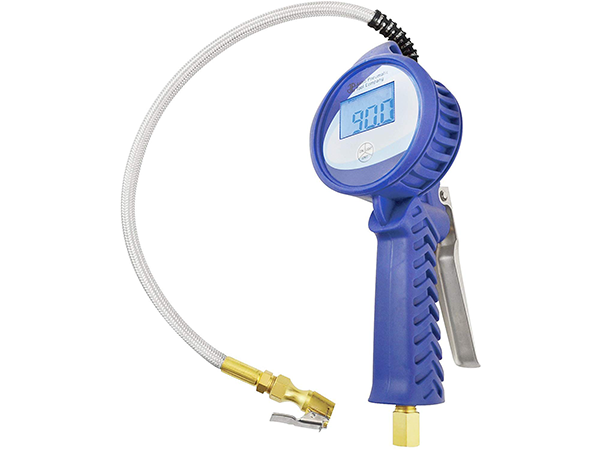
PROS
- Very high-quality and durable
- Braided steel hose
- Full set (inflator, hose, gauge)
- Accurate readings up to 174 PSI
CONS
- Very pricey
Astro tools are known to be high-quality, longevous purchases. This, of course, comes with a notable price hike, especially when compared to some of our other entries. While its function is certainly respectable, it might not be suitable for the less car-savvy buyers.
Quality-made inflator/gauge with unparalleled design.
The Astro 3.5” inflator can read up to 174 PSI with high precision, with a ±2.0 psi error range at most. Its design is probably the most striking aspect, though, and gives off the impression of very thoughtful and considerate construction choices. Firstly, the handle has ridges and is made of very durable rubber, contributing to a non-slip grip. In addition, the hose is made of braided steel, adding both efficiency and considerable durability.
The large, LCD-lit screen is easily readable, and the results themselves (like the AstroAIs) come in four different units with a 0.1 increment. Overall, the comfort and precision of this tool makes it a solid buy for more seasoned mechanics, but the price point might put off some first-time users of pressure gauges—especially if you’re not looking for an inflator.
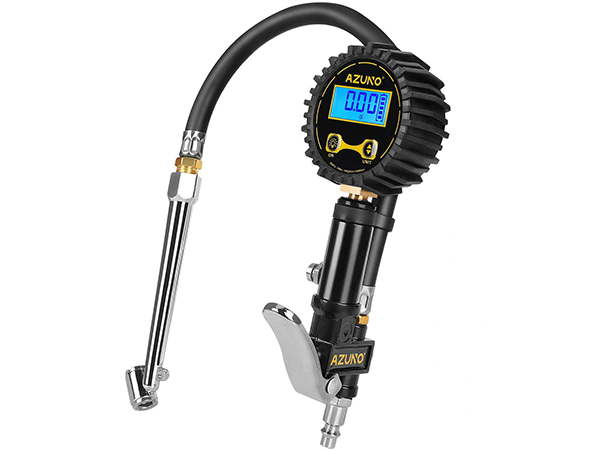
PROS
- Very high-quality and durable
- Full set (inflator, hose, gauge)
- Accurate readings up to 200 PSI
- Very user-friendly design and function
CONS
- 0.5 display resolution
The Azuno inflator/gauge set is impressive to look at and offers assurances of lifetime durability. However, despite the rock-solid design, it does sacrifice a bit in appearance; to put it simply, it looks a bit wonky.
It does everything you need from a professional pressure gauge.
Despite the borderline uncomfortable design of the gauge, it has everything you’d need to both monitor and adjust your tire pressure. The only obvious drawback of this product is the 0.5 display resolution; essentially, if your actual tire pressure is 35.3 or 35.6 psi, they’ll both show up as 35.5. While this does ensure accurate readings, it’s not as precise as the competing brands that offer 0.1 resolution.
Either way, you’re getting a bang for your buck with this set. It works right out of the box once you attach all the required components, which isn’t a tough task. Users have noted that it is very easy and convenient, notably the valve chuck and bleeding mechanism. Despite the 0.5 resolution, users lauded this product for its accuracy in deflation and inflation—to be fair, you don’t particularly need the precision of 0.1 for optimal pressure levels anyway. To summarize, this product impressed a vast majority of buyers, both in function and form. In fact, some even said it was comfortable in their hand, something that disproves the “wonky” impression you might get.
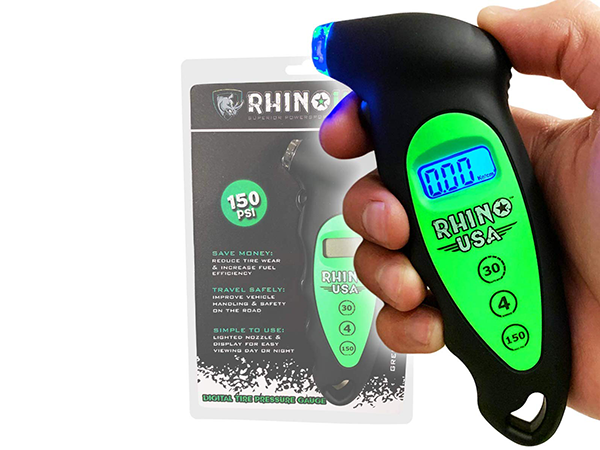
PROS
- Ergonomic
- Versatile use
- Very affordable
- Guaranteed refund
- Good for beginners
CONS
- No precision standard outlined
- Often flimsy (namely the top button)
Another budget option, the Rhino USA model is fairly similar to our chosen “Best Price” product, the AstroAI 150PSI. In fact, the similarities are down to the smallest details, from the product description to the finger ridges. How does it compare in functionality?
This device is credible even with the price it has.
The Rhino USA pressure gauge, like the AstroAI, is very budget-friendly. It displays results in four units but has no indication of a display resolution. It has a lit nozzle that makes it easier to work in darker conditions, and, based on the reviews, is a fairly solid product. As an “entry-level” pressure gauge, it’s certainly one to consider if you’re dipping your toes in the market.
However, it’s a fairly barebones option (like the AstroAI), propelled mostly by the fact that it is made by a father/son business.
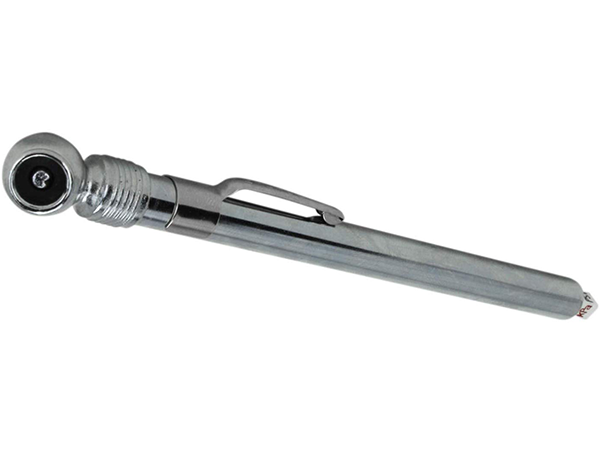
PROS
- Very small and portable
- Reads in two units (PSI, kPa)
- Extremely affordable
- Suitable for cold weather
- Good for all levels of mechanics
CONS
- Larger error range than most
- Inaccurate for a few users
Our final entry is here to spice things up a bit; with all of the analog and digital gauges on this list, the Milton S-921 offers a reliable and simple pencil gauge as an alternative. If you’re looking for portability, this gauge is quite literally the size of a pen.
We found it a lightweight and surprisingly effective pressure gauge.
If you’re unfamiliar with how a pencil gauge works, it’s quite simple, really. The chuck is connected to the tire, and the air in the tire enters a piston in the gauge, which is pushed back by a spring in the gauge itself, achieving a delicate balance (this also prevents the scale at the end from flying off immediately). The tire pressure slowly expands the inner chamber of the gauge until it reflects the pressure in the tire. Basically, the air in the tire slowly pushes the scale-out of the gauge itself until it stops on the accurate reading.
A big plus for those who are concerned about local-made products is the fact that every part of this model is made in the USA. It is also decently accurate (to ±1 psi), and reads both psi and kilopascal (kPa). The biggest selling point, though, is probably its portability; it is so small it can get lost in your glovebox or fit in your pocket. As you might expect, it is also very affordable but is probably more suitable for handier drivers.
Why Do Car Owners Need a Tire Pressure Gauge on Board?
As we touched on in the intro, under or overinflated tires can have dire long-term consequences if unchecked. Underinflation is a large cause of certain inefficiencies in areas such as steering and fuel efficiency. Meanwhile, overinflation increases the total surface of the tires for the same level of rotation, leading to wear and tear. Of course, in either case, flat tires are a serious possibility, so it’s important to ensure proper pressure levels across all the tires in your car.
See also: The Best Portable Tire Inflators
By having a tire pressure gauge (and inflator, if you need one), you secure the longevity of your tires and help your car run smoothly overall. Similarly, optimal tire pressure might vary with the seasons (depending on where you live), so adjusting that when necessary can be done simply with a gauge and inflator. Most gauges come with a bleed valve regardless, so fixing overinflation is quite simple and usually doesn’t require an inflator.
Even if you notice some sort of issue with how your car is driving, doing a quick check with your gauge could give you an idea of what’s wrong. Whatever type of gauge you go for, shelling out a bit of money on a gauge is a no-brainer when your tire condition is on the line.
How to Pick Out the Best Tire Pressure Gauge?
Picking out the tire pressure gauge that’s perfect for you could be simple if you know what you’re looking for, or daunting if you don’t. The first decision you need to make realizing what kind of gauge you’d be comfortable with. If you want an LCD/LED-backlit display with a digital meter, that already narrows it down quite a bit. On the other hand, you might prefer a simpler analog gauge, whether it’s a pencil gauge or a regular circular dial. Your search ideally starts here.
Next, you’ll want to look into whether or not you need different components; a tire inflator with gauge is typically cheaper than buying both separately, so if you need an inflator you could search for a set. Essentially, you want to make sure you have everything you need to use the gauge itself.
Finally, the decision is ultimately up to you; maximum PSI is not very important as long as it’s around 60+, as best modern car tires go up to about 50 anyway. The other factor to consider is – you guessed it – price. Don’t be afraid to shell out extra cash for a solid and reliable pressure gauge, either, as it might last you a lifetime. At the same time, you can definitely find a precise and durable gauge for about $20.
Which tire pressure gauges require batteries?
To put it simply, if the pressure gauge has a digital interface (LCD screen, for example), it requires batteries. However, analog gauges (pencil, dial) use mechanical force to identify pressure, so obviously they won’t ever be needing batteries.
What are all the different pressure units?
It might be confusing for some as to why so many gauges come with 4 different possible readings. Basically, different situations have different conventions, but usually, PSI (pounds per square inch) is the dominant unit. Similar to psi is kPa, where Pa is pascal (Newtons per square inch) and k is kilo (so a kPa = Pa/1000). The unit bar expands on this still, where 1 bar = 100kPa. This measurement is used because it is the approximate pressure in our atmosphere. Finally, there is Kg/cm², yet another way to measure the same thing—in this case it’s the kilograms per square centimeter (kind of like the metric version of psi). At the end of the day, it depends on which measurement you need.
Can I use pressure gauges on other types of tires?
Tire pressure gauges are practically universal, as they are simply a way to measure pressure in a given space. So, if you want to check your bike tires, it’s certainly possible.
What is the optimal tire pressure level for cars?
Typically, you’ll want about 30-35 PSI of pressure in your tires under normal conditions. However, in very cold and wet weather, bumping up your usual psi by 3-5 is possible to offset the slowing of responsiveness.
How to Use a Tire Pressure Gauge?

Getting Started.
Using a tire pressure gauge is quite straightforward. The only thing you need to make certain of is that your connection to the tire is secure and has no air leaks. Once that is certified, you’re good to go.
Most tire pressure gauges have sophisticated chucks that allow you to secure them to your tire in seconds. First, you want to unscrew the cap on the valve on your tire. Once it’s completely off, connect your gauge to it via the chuck on the end of it. Once it begins reading, you know it’s successfully connected. However, if it’s fluctuating, you have to make sure there are no air leaks; some chucks come with a lock mechanism to clasp it to the tire valve.
When your gauge readings are consistent across a few seconds, you have your tire pressure. Next, you’ll want to adjust it if it’s over or underinflated.
Adjusting Tire Pressure.
Adjusting the pressure in your tires is no huge challenge, either. First, make sure your tires are under or overinflated; like stated before, 30-35 is ideal. If you’re, say, at 40 psi, you’ll want to “bleed” the tire a bit. Many (if not most) high-quality gauges come with their own bleed valve. If yours has one, then you simply need to open it up and release a bit of air little by little. Make sure to monitor the tire pressure as you go along so as to not overdo it.
If your psi is under the recommended levels, grab your inflator and get to work. Connect the inflator (or, if you have an inflator with gauge, it should already be attached) to the tire valve and add some air, usually done via a trigger on the handle. Like bleeding the tire, you’ll want to alternate between adding air and checking your tire pressure to make sure you don’t go over the recommended PSI. There’s not much else to it.
Side Note: Winter
You might notice that your vehicle manufacturer recommends a higher psi for winter tires than all-season or summer tires. Is this really necessary, and why?
There are several factors that impact tires during cold weather: typically, due to the rugged nature of winter tires, they might not be as responsive as all-season tires. As such, increasing the psi will offset that. In addition, hotter temperatures lead to heat pressure buildup, so colder weather is going to limit the amount of pressure you get from heat and friction. So, adding a few psi might help get it back to optimal levels.
- Using Your Tire Air Pressure Gauge The Right Way – Christian Brothers Automotive
- Filling air into car’s tires – Wikihow
- https://www.nhtsa.gov/ – National Highway Traffic Safety Administration (NHTSA)
We do an efforts to find, research and recommend the best products. So, we may receive commissions from purchases that you make after following the links in our product reviews.
Related Products
-

Best Air Compressors For Home Garage Use in 2025 (Review)
-

Best Car Phone Mounts and Holders for Convenient Use in 2025
-

3 Best Shock Absorbers for Smooth and Precise Driving in 2025
-

Best Electric Vehicle Chargers For Home (TOP Products Review and Buyer’s Guide)
-

Best Windshield Wipers and Wiper Blades Shortlisted in 2025


